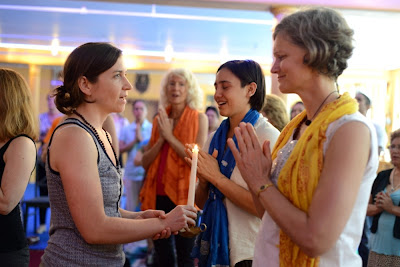Q &
A with Dharma Yoga Teachers around the World…
This week: Gail Super in Cape Town, South
Africa
By Nicole Sopko
Gail Super is a Dharma Yoga teacher and student who lives in beautiful South Africa. She says, “I am constantly amazed by how deep this
practice of yoga is. I lead a really busy life and have many family
responsibilities but my daily yoga practice allows me to cope with all of this.
I am deeply grateful to Sri Dharma Mittra for his teachings and to the universe
for leading me to his classes.”
Where do you live and teach?
I live in Cape Town with my 14
year old daughter, one dog, two kitties, and lots of baby geckos.
I
am teaching Dharma I from my home in Vredehoek, Cape Town. I created a
beautiful studio in a downstairs room and I teach on a Tuesday evening from 6-7
pm. I plan on adding more classes and also to teach some workshops.
The
name of the studio is Dharma Yoga Cape Town. My cats love to join me in my
practice in the studio!
Which Dharma Yoga Life of a Yogi trainings have you completed? How did you come to do
those trainings?
I completed the LOAY 200-hour training. I used to
live in NYC and fell in love with Sri Dharma after taking my first class with
him on my 40th birthday. I started to attend his noon class every day.
Unfortunately, a year later I had to return to South Africa. Doing the teacher
training was a way for me to spend more time with Sri Dharma; steeping myself more
deeply in the teachings and hopefully spreading his light.
Have the people you met during your training inspired you?
I met the most amazing people in the LOAY
training. They have become lifelong friends and they have inspired me to read
more of the scriptures and to spread the teachings.
What is one practice that you do every day?
Asana, pyschic development, pranayama and just
sitting...every day.
How has your experience in the LOAY program affected
your life outside of training?
I started to read more of the scriptures,
started to develop a daily practice of psychic development and pranayama and I
transitioned to a raw/live food way of life.
Do you have another job?
Yes. I am currently working on my postdoctoral
research on punishment in South Africa at the University of Cape Town. My book
“Governing through Crime in South Africa, the politics of race and class in
neoliberalizing regimes” is about to be published!
What are you currently reading/studying?
I am reading the Yoga Vasisthasa as a well as
Martin Amis' latest book (a novel).
________________________________________________
Nicole Sopko(Gopi Om) is a Dharma Yoga teacher living in Chicago, IL where she teaches Dharma Yoga and operates a nationwide vegan natural food company alongside her (life) partner. She takes great care to be always aware of the ways in which these two responsibilities intersect and spends her time promoting compassion in all forms. She is a dedicated and loving student of Sri Dharma’s and visits New York as frequently as possible to absorb the benefits of his holy teachings in person.
















